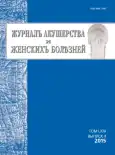The optimization of reparative processes after cesarean section (clinical-experimental research)
- Authors: Aylamazyan E.K.1, Andreeva V.Y.1, Kuzminykh T.U.1, Sokolov D.I.1, Selkov S.A.1, Tral´ T.G.1, Tolibova G.H.1, Yakovleva A.A.1
-
Affiliations:
- D. O. Ott Research Institute of Obstetrics and Gynecology, RAMS
- Issue: Vol 64, No 4 (2015)
- Pages: 4-12
- Section: Articles
- URL: https://journals.rcsi.science/jowd/article/view/1221
- DOI: https://doi.org/10.17816/JOWD6444-12
- ID: 1221
Cite item
Full Text
Abstract
Full Text
##article.viewOnOriginalSite##About the authors
Edvard Karpovich Aylamazyan
D. O. Ott Research Institute of Obstetrics and Gynecology, RAMS
Email: iagmail@ott.ru
academician, professor, the chief
Victoriya Yuryevna Andreeva
D. O. Ott Research Institute of Obstetrics and Gynecology, RAMS
Email: v.y.andreeva@gmail.com
postgraduate, Delivery Department
Tatiana Ulyanovna Kuzminykh
D. O. Ott Research Institute of Obstetrics and Gynecology, RAMS
Email: iagmail@ott.ru
MD, Head of the Delivery Department
Dmitriy Igorevich Sokolov
D. O. Ott Research Institute of Obstetrics and Gynecology, RAMS
Email: falkojugger@yandex.ru
MD, senior staff scientist
Sergey Alekseevich Selkov
D. O. Ott Research Institute of Obstetrics and Gynecology, RAMS
Email: selkovsa@mail.ru
MD, Professor, laboratory of immunology
Tatyana Georgievna Tral´
D. O. Ott Research Institute of Obstetrics and Gynecology, RAMS
Email: TTG2008@bk.ru
MD, Pathologist, department of pathomorphology
Gulrukhsor Haybulloevna Tolibova
D. O. Ott Research Institute of Obstetrics and Gynecology, RAMS
Email: gulyatolibova@mail.ru
PhD, MD, senior scientist, department of pathomorphology
Anastasia Alexandrovna Yakovleva
D. O. Ott Research Institute of Obstetrics and Gynecology, RAMSResearcher, Laboratory of physiology and pathology of the fetus
References
- Ананьев В. А. Осложнения и заболевания после кесарева сечения в послеродовом и отдаленном периодах. Акушерство и гинекология. 2005; № 2: 52-4.
- Ананьев В. А. Повторное кесарево сечение. Российский вестник акушера-гинеколога. 2003; № 1: 53-5.
- Айламазян Э. К. Кесарево сечение. Обшие проблемы и региональные особенности. Журнал акушерства и женских болезней. 2005. № 4: 3-10.
- Айламазян Э. К., Павлова Н. Г., Поленов Н. И. Морфофункциональная оценка нижнего сегмента матки в конце физиологической беременности и у беременных с рубцом. Журнал акушерства и женских болезней. 2006. Т. LV, вып. 4:11-8.
- Брискин Б. С. Применение биопластического материала «Коллост» для лечения раневых дефектов у пациентов с осложненными формами синдрома диабетической стопы. М.: Медицина. 2009: 53-63.
- Буянова С. И., Пучкова Н. В. Несостоятельность рубца на матке после кесарева сечения: диагностика, тактика ведения, репродуктивные прогнозы. Российский вестник акушерства и гинекологии. 2011; № 4: 36-8.
- Густоварова, Т. А. Беременность и роды у женщин с рубцом на матке: клинико-морфологические и диагностические аспекты. Автореф. дис. … д-ра. мед. наук. М.; 2007.
- Краснопольский В. И., Логутова Л. С., Гаспарян Н. Д. Альтернативное родоразрешение беременных с оперированной маткой. Журнал акушерства и женских болезней. 2003. №.1: 20-5.
- Логутова, Л. С. Пути снижения частоты абдоминального родоразрешения в современном акушерстве. Российский вестник акушерства и гинекологии. 2008. № 1: 57-61.
- Манухин, И. Б. Повторное кесарево сечение с хирургической позиции: систематический обзор. Журнал акушерства и женских болезней. 2011. Т. LX.: 69-70.
- Телегина, И. В. Влияние характера родоразрешения на формирование рубца на матке после операции кесарева сечения. Автореф. дис. … к-та. мед. наук. СПб.; 2013.
- Фаткулин И. Ф., Габидуллина Р. И., Галимова И. Р. Сравнительный анализ результатов кесарева сечения: выбор шовного материала и метода наложения шва на матку. Российский вестник акушера-гинеколога. 2001; № 1: 83-5.
- Эканем Эванс. Оптимизация ведения беременности и родов у женщин с рубцом на матке. Автореф. дис. … канд. мед. наук. Алма-Аты.; 2004.
- Coassolo K. M., Stamillio D. M., Pare Е. et al. Safety and efficacy of vaginal birth after cesarean attempts at or beyond 40 weeks of gestation. Obstet. Gynecol. 2005; 106 700-6.
- Doğanay М., Tongus Е. А., Var Т. Effects of method of uterine repair on surgical outcome of cesarean delivery. Int. J. Gynecol. Obst. 2010; 111: 175-8.
- Konuam L., Nkemayim D. C., Nsangou Tebeu P. M. Vaginal delivery after caesarean section: a prospective study of 146 cases. Zentralle Gynakol. 2006; 128: 213-6.
- Pollio F., Staibano S., Mascolo M., Salvatore G., Persico F., De Falco M., Di Lieto A. Uterine dehiscence in term pregnant patients with one previous cesarean delivery: growth factor immunoexpression and collagen content in scarred lower uterine segment. Am. J. Obstet. Gynecol. 2006; 194 2: 527-34.
- Silver R. M., Landon M. B., Rouse D. J. Maternal morbidity associated with multiple repeat cesarean deliveries. Int. J. Gynecol. Obst. 2006; 107 (6): 1226-32.
- Shao M. J., Hu M., Hu M. X. Conservative management of cesarean scar pregnancy by local injection of ethanol under hysteroscopic guindance. Int. J. Gynecol. Obst. 2013; 121 (3): 281-2.
Supplementary files







